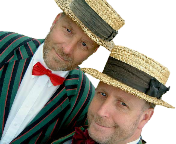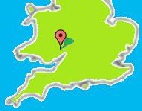












Open daily from 10:00 and lovely and warm!




Nature Notes from Symonds Yat
Nearly a hundred years ago, A.B. Farn started to send brief “Nature Notes” to the Woolhope Field Naturalists’ Club about the birds and butterflies on The Doward, a wooded hill which towers dramatically above Symonds Yat. Looped by the River Wye, The Doward has a microclimate very like that of the Dordogne in France, so it’s a great place to meet wild butterflies.
Lindsay Heyes of the Wye Valley Butterfly Zoo at Symonds Yat brings the record up to date for 2011. If you want to find out what to look for yourself in the Upper Wye Gorge, check out our Spotter’s Guide.
March
I saw all of last year’s butterflies that over-winter as adults, although the wide-ranging Brimstone and the Peacock were not then on The Doward. March is the time of year when I feel the excitement of spring just around the corner. The days feel longer, but one clear day starts with that strange mix of frost crunching underfoot to the tune of a deafening dawn chorus. Spring? Maybe. As I leave my house I see the first butterfly: It’s a Comma, the signature insect of Herefordshire. It’s fast and almost black, but the shape of the wings identifies it from twenty feet away as it flits joyously over my neighbour’s hedge. Two Peacock butterflies fly over my car as I arrive at the Wye Valley Butterfly Zoo and they settle on the wall of the glasshouse to eye-up the sun. Not quite spring...
The following day I have to visit Ledbury, and drop in on Ken Davies at Woodside Lodges. He’s an old friend who does everything he can to encourage wildlife at his holiday park, but he’s out for the day. It’s a sun-trap, and as I get back in the car a Brimstone comes briskly up the hill from the direction of the lake, brilliant yellow, and brushes along the pine wall of Ken’s lodge before fluttering crazily into the woods behind. Now it IS spring!
I’m anxious to get out on The Doward, but can’t until after lunch the next day, the 27th March. A Small Tortoiseshell crosses my path, not fifty yards from A.B. Farn’s old house, and settles in the sticks by the embankment. It doesn’t move. I wish I had my camera with me. The path has a hairpin bend, and I see another Small Tortoiseshell directly above the other one, following exactly the same flight-path. Why do they do that?
As I climb the steep path with no leaves on the trees, the sun warms damp leaf-litter in the woods, awakening steamy decay which warms the deep piles of leaves that gather between tree roots, in crevices in the cliffs and in grykes of the limestone pavement near the summit. The insects are on the move, or at least the Spring Flower Bees, fatties which bumble their way across the tracks in a fruitless search for flowers. Birds crowd into the woods to rummage through the leaves or swoop between the trees for a feast. They are skittish and shy and tantalisingly out of range for identification: I hear a buzzard by the cliff and realize why, and although I can’t see it, I feel foolish because my binoculars are in the car, keeping my camera company.
A cloud is blown across the sun, and I realise immediately that the wind is too cold for butterflies this high up and this late in the afternoon. I feel cold too, so I head back to the Butterfly Zoo to warm up in its tropical temperatures and admire the velvet-dark venation of the Indian Tiger butterfly that had emerged that morning, the first of its species that we have raised.
April
As March turns into early April I hope to meet the first of this year’s butterflies on warm days. The first sunny day is the 2nd April, there’s a cool breeze and the morning is dull, but in the afternoon the sun is out and I’m up on the hill with my wife and oldest daughter. We’re not fifty paces up the track when we hear a buzzard, and we look up to see a pair of them. They are circling through the tree tips, strangely not being mobbed by crows. This time I have my camera. They come directly over my head, just thirty feet up, but I can’t focus on them before they fly into the sun. I turn to see my family a hundred yards ahead. So, the agenda is exercise, if only I had known. It takes ages to catch up. I keep thinking that they will miss the wildlife... they will.
I can’t see any butterflies as I round the hairpin, so I look up to see how far ahead they are, and then I see it. I see it for just the second time in my life: The stoop. That’s the name for the dive of a peregrine falcon. I see it cross the track about six feet above the trees like an arrow, its wings drawn in and swept back. Not like an arrow, an arrow arcs to its target, this is dead straight, and rocket fast. In a flash it is out of the wood two hundred yards below me, still locked onto its target. I lose sight of it after another two hundred yards, and wonder what it was hunting.
I catch up with the family as they pass through a gate, but they put up the first butterfly of the day, a Comma. It settles on a stone, catching the sun, and I try to photograph it. It gets up again, crosses the gate and lands on the other side. I go through the gate, get it in focus... And it’s up and back over the gate. This goes on for ages. My family are out of sight again, and I see what looks like another Comma land on the track fifty yards up, so I give up on this one. I can’t find the one up the track, so I hurry on, and finally catch up with the ladies, who are relaxing on a bench. Suddenly the difference between March and April reveals itself in its full glory: wild flowers. Everywhere. And it’s good this year. Wood anemones, primroses, daisies, daffodils, dandelions, wild strawberries, celandines, some thin and straggly bluebells... and violets.
We head up to the iron age camp and I am grinning. Violets are the hosts for Fritillaries, and we have never seen so many of them as we get to the earth ramparts. A Red Admiral flies between us into the woods just as we get out in the open. It should be a great summer. I can see butterflies by the trig point, and when I get there it is three commas chasing each other. We walk around the camp. The violets are everywhere. This is wonderful, because this ground was only cleared a year ago. Cattle were brought in to recondition the land and keep it clear. They are gone, but the grazed grass indicates that the deer are keeping it down. This is essential for the Fritillaries, because if the grass shades the violets the caterpillars won’t prosper.
We enjoy the view and head down the hill to the place that I call the Fritillary Fun Park. We catch sight of a Peacock above the path. It’s behind brambles, so I can’t photograph it, and the bank is too steep and friable to climb. I wait. Two other Peacocks arrive. They dance in the sun. They take turns to land on the other side of the bramble, teasing me. I run after them, first one way, then the other. Fail. I walk on, having worked up a sweat. Then I feel it. One of the Peacocks kisses the top of my head to take the salt. I turn, and it nips over the brambles again.
As we walk back to the car we catch sight of a pair of Peacock butterflies in the wood, and the herd of deer resting in the sun, following us with their eyes so that their antlers seem like direction-finding antennae from Cold War spy films. A last Comma flutters by, and we head off to The Hostelrie in Goodrich for a pint of Hereford Brewery’s wonderful Gamekeeper’s Bitter and a very large draught of real country pub atmosphere. Perfect, but I missed the Brimstones, and I had to wait until 6th April to see my first Orange Tips fly up the stream by my MiniGolf course. The butterflies are emerging late this year.
Lindsay Heyes
© Wye Valley Butterfly Zoo 1st April 2011